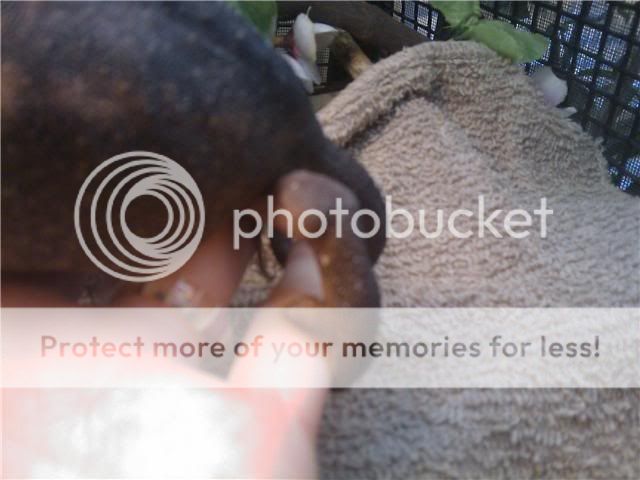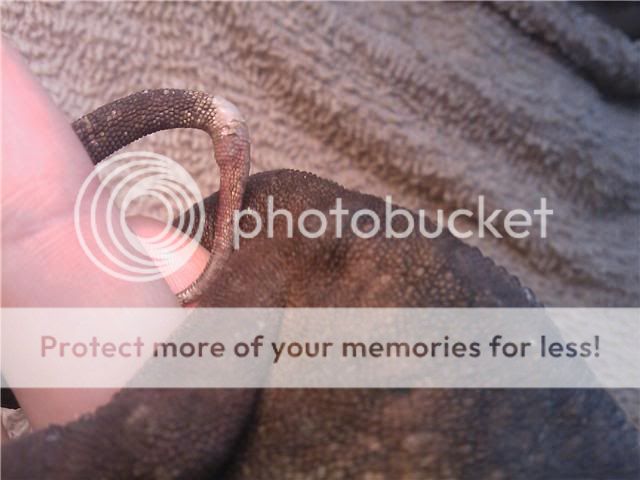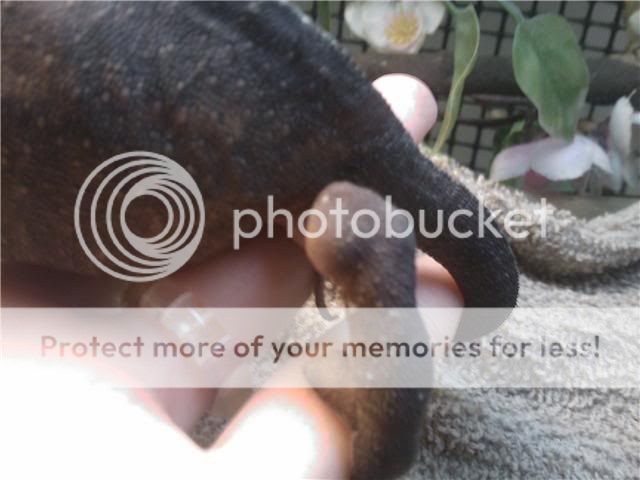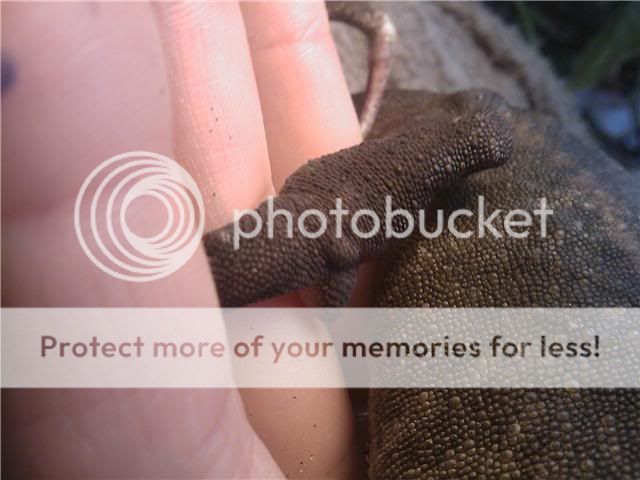lbesok
Avid Member
Chameleon Info:
*Your Chameleon- Lula. Female Ambilobe Panther Chameleon. She is over 3 years old, has been in my care now for a little over a year, and was cared for by a close friend of mine prior to that.
* Handling - I currently only handle her when necessary to feed, provide meds, or move to a more comfortable position.
* Feeding - Strictly silk worms (for now) she is accepting ~2 per day. Silkies only eat their chow.
* Supplements - Plain calcium 2-3x per week calcium w/d3 1-2x per month multi vit. 1-2x per month.
* Watering - Professional misting system 3x a day 2.5min each cycle. I also place her in the shower to stimulate her to drink and then carefully offer her water from a baster.
* Fecal Description - Does not seem as consistent as normal, last fecal looks a little liquidy. Cham has been tested for parasites, but not at this past vet visit.
* History - Lula is a very sweet natured and strong willed chameleon. She has been through parasites and a URI with me. I hate to see her the way she is and hope that some advice may be offered to alleviate her.
Cage Info:
* Cage Type - Standard screen cage, 16*16*20.
* Lighting - Standard Lighting 60W heat bulb and repti-sun 5.0 UVB light. On at 7 off at 6.
* Temperature - Temps seem to be standard when measuring with temp gun. Daytime ambient is ~80* in the lizard room. Cage gradiant 68*-88* Does not drop below 63* in the house at night.
* Humidity - Humidity changes from 40-60% during the day. The misting system along with buckets to catch the water underneath the cage help to maintain humidity. A hygrometer is used to measure the humidity.
* Plants - One pathos and vines are located in her cage. Plastic chicken wire is also lined around the cage.
* Placement - The cage is amongst others in the Lizard room. Lula lives between Vega and Joppa. Her cage is straight ahead as soon as you walk in to the room. A heat vent is near her cage but not blowing on her cage. Top of the cage is 4.5ft from the floor.
* Location - Just moved from Lake Wales/Tampa, FL to Valdosta, GA.
Current Problem - A couple of weeks ago (right after I moved) I noticed that Lula's joints seemed to be getting swollen. It seemed similar to what I've seen before on chams with MBD but with my current husbandry situation, it did not fit. She's been falling the bottom of her cage. I have draped a cloth over the top of branches to make her more comfortable, and mom made her a bed to sleep in at night. She is still eating, but having a hard time gripping and staying up on her branches, though she still seems very active, and roams around the cage grabbing the chicken wire hanging vetically. Her back ankles/elbows are the worst. Almost swollen but a hard swollen. Also appears that one hip bone is even a bit swollen.
She went to the vet about a week after symptoms were first noticed. A blood test was done to indeed classify her condition as gout. Her uric acid levels were high at ~12 and the other ratios seemed normal. The vet recommended keeping her well hydrated and to offer her watery foods like silkies and horn worms. She was also prescribed, Allopurinol, which was received 2-10 after compounding, to help decrease the fluid/mass? in her joints.
Does any one have any other advice to offer in regards to Gout and methods or procedures I could utilize to increase her chances of making it through this. I have never dealt with this condition, so any help or advice is greatly appreciated.
I was wondering if soaking her in warm water would possibly reduce the swelling? Was also wondering if a light massage to those areas may also help to disperse the mass, but I don't want to hurt her. When humans acquire gout oftentimes organic cherry juice is recommended to help reduce the symptoms, would this be a possibility in her case, by either gutloding with it or diluting it??
Was debating whether or not to add the photos because they are so sad




Seems like two things may have come as a result of the gout. The tip of her tail has become necropsic, since the condition was diagnosed, and looks similar to previously dealt with juvenile niptails. I am treating it, like so with a topical. Also she has grabbed her front arms with her back feet so hard that their are scratches and cuts on her front arms, I thought at first might be some sort of skin infection. After further examination, pieces of leftover black skin were found on her toenails leading me to believe this was self inflicted.
Thank you in advance for any advice.
*Your Chameleon- Lula. Female Ambilobe Panther Chameleon. She is over 3 years old, has been in my care now for a little over a year, and was cared for by a close friend of mine prior to that.
* Handling - I currently only handle her when necessary to feed, provide meds, or move to a more comfortable position.
* Feeding - Strictly silk worms (for now) she is accepting ~2 per day. Silkies only eat their chow.
* Supplements - Plain calcium 2-3x per week calcium w/d3 1-2x per month multi vit. 1-2x per month.
* Watering - Professional misting system 3x a day 2.5min each cycle. I also place her in the shower to stimulate her to drink and then carefully offer her water from a baster.
* Fecal Description - Does not seem as consistent as normal, last fecal looks a little liquidy. Cham has been tested for parasites, but not at this past vet visit.
* History - Lula is a very sweet natured and strong willed chameleon. She has been through parasites and a URI with me. I hate to see her the way she is and hope that some advice may be offered to alleviate her.
Cage Info:
* Cage Type - Standard screen cage, 16*16*20.
* Lighting - Standard Lighting 60W heat bulb and repti-sun 5.0 UVB light. On at 7 off at 6.
* Temperature - Temps seem to be standard when measuring with temp gun. Daytime ambient is ~80* in the lizard room. Cage gradiant 68*-88* Does not drop below 63* in the house at night.
* Humidity - Humidity changes from 40-60% during the day. The misting system along with buckets to catch the water underneath the cage help to maintain humidity. A hygrometer is used to measure the humidity.
* Plants - One pathos and vines are located in her cage. Plastic chicken wire is also lined around the cage.
* Placement - The cage is amongst others in the Lizard room. Lula lives between Vega and Joppa. Her cage is straight ahead as soon as you walk in to the room. A heat vent is near her cage but not blowing on her cage. Top of the cage is 4.5ft from the floor.
* Location - Just moved from Lake Wales/Tampa, FL to Valdosta, GA.
Current Problem - A couple of weeks ago (right after I moved) I noticed that Lula's joints seemed to be getting swollen. It seemed similar to what I've seen before on chams with MBD but with my current husbandry situation, it did not fit. She's been falling the bottom of her cage. I have draped a cloth over the top of branches to make her more comfortable, and mom made her a bed to sleep in at night. She is still eating, but having a hard time gripping and staying up on her branches, though she still seems very active, and roams around the cage grabbing the chicken wire hanging vetically. Her back ankles/elbows are the worst. Almost swollen but a hard swollen. Also appears that one hip bone is even a bit swollen.
She went to the vet about a week after symptoms were first noticed. A blood test was done to indeed classify her condition as gout. Her uric acid levels were high at ~12 and the other ratios seemed normal. The vet recommended keeping her well hydrated and to offer her watery foods like silkies and horn worms. She was also prescribed, Allopurinol, which was received 2-10 after compounding, to help decrease the fluid/mass? in her joints.
Does any one have any other advice to offer in regards to Gout and methods or procedures I could utilize to increase her chances of making it through this. I have never dealt with this condition, so any help or advice is greatly appreciated.
I was wondering if soaking her in warm water would possibly reduce the swelling? Was also wondering if a light massage to those areas may also help to disperse the mass, but I don't want to hurt her. When humans acquire gout oftentimes organic cherry juice is recommended to help reduce the symptoms, would this be a possibility in her case, by either gutloding with it or diluting it??
Was debating whether or not to add the photos because they are so sad




Seems like two things may have come as a result of the gout. The tip of her tail has become necropsic, since the condition was diagnosed, and looks similar to previously dealt with juvenile niptails. I am treating it, like so with a topical. Also she has grabbed her front arms with her back feet so hard that their are scratches and cuts on her front arms, I thought at first might be some sort of skin infection. After further examination, pieces of leftover black skin were found on her toenails leading me to believe this was self inflicted.
Thank you in advance for any advice.
Last edited:





